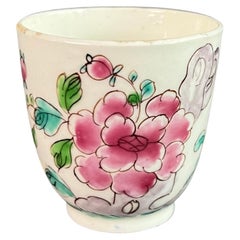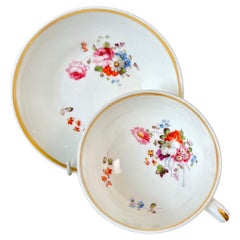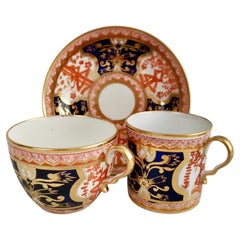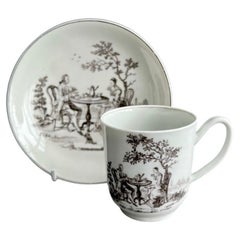Want more images or videos?
Request additional images or videos from the seller
1 of 13
Miles Mason Orphaned Porcelain Coffee Can, White, Bat Printed Minerva
$240List Price
About the Item
- Creator:Miles Mason Porcelain (Maker)
- Dimensions:Height: 2.6 in (6.61 cm)Diameter: 2.6 in (6.61 cm)Length: 2.6 in (6.61 cm)
- Style:Regency (Of the Period)
- Materials and Techniques:
- Place of Origin:
- Period:
- Date of Manufacture:circa 1810
- Condition:Wear consistent with age and use. In excellent antique condition.
- Seller Location:London, GB
- Reference Number:Seller: A-MAS161stDibs: LU4805121884252
About the Seller
5.0
Vetted Professional Seller
Every seller passes strict standards for authenticity and reliability
Established in 2016
1stDibs seller since 2019
227 sales on 1stDibs
Typical response time: 2 hours
Authenticity Guarantee
In the unlikely event there’s an issue with an item’s authenticity, contact us within 1 year for a full refund. DetailsMoney-Back Guarantee
If your item is not as described, is damaged in transit, or does not arrive, contact us within 7 days for a full refund. Details24-Hour Cancellation
You have a 24-hour grace period in which to reconsider your purchase, with no questions asked.Vetted Professional Sellers
Our world-class sellers must adhere to strict standards for service and quality, maintaining the integrity of our listings.Price-Match Guarantee
If you find that a seller listed the same item for a lower price elsewhere, we’ll match it.Trusted Global Delivery
Our best-in-class carrier network provides specialized shipping options worldwide, including custom delivery.You May Also Like
Miles Mason Porcelain Coffee Can Blue & White Broseley Gilded Ptn 50, circa 1808
By Miles Mason Porcelain
Located in Lincoln, Lincolnshire
This is a porcelain blue and white, gilded Coffee Can made by Miles Mason (Mason's), Staffordshire Potteries, in the early 19th century George 111rd period, circa 1805-1810.
The piece is well potted with vertical flutes, a slightly wavy rim and the loop handle with the distinctive thumb rest spur.
The can is decorated in the under-glaze blue printed Pagoda or Broseley, chinoiserie Willow pattern, (sometimes called Boy at the Door pattern). The piece is also richly gilded in Miles Mason pattern 50 as illustrated on Page 78 of the book; Miles Mason Patterns and Shapes, produced by the Mason's Collectors' Club. The coffee can is also hand gilded around the rims and on the outer handle.
The piece is fully marked to the base with an under-glaze blue printed square seal mark (pseudo Chinese) as illustrated on page 92 of the above publication.
Overall a very good Georgian coffee can...
Category
Antique Early 19th Century English Chinoiserie Ceramics
Materials
Porcelain
$222
H 2.5 in W 3.4 in D 2.63 in
Miles Mason Coffee Can & Saucer Porcelain Chinamen on Verandah Pattern, Ca 1805
By Miles Mason Porcelain
Located in Lincoln, Lincolnshire
This is a Miles Mason Duo of two pieces of blue and white hand gilded porcelain comprising a coffee can and a saucer, all in the Chinaman on Verandah pattern, made by Miles Mason (Ma...
Category
Antique Early 19th Century English Chinoiserie Porcelain
Materials
Porcelain
$282 / set
H 1.13 in Dm 5.5 in
Georgian Miles Mason Coffee Can & Saucer Porcelain Hand Gilded Ptn C13, ca 1805
By Miles Mason Porcelain
Located in Lincoln, Lincolnshire
This is a fine porcelain coffee can & saucer duo made by Miles Mason, of Lane Delph, Stoke on Trent, England, circa 1805. It has a plain loop handle with the characteristic upper spu...
Category
Antique Early 19th Century British Georgian Porcelain
Materials
Porcelain
$350 / set
H 1.32 in Dm 5.38 in
Miles Mason Porcelain Sucrier Blue and White Broseley Willow Pattern, circa 1810
By Miles Mason Porcelain
Located in Lincoln, Lincolnshire
This is a porcelain blue and white, hand gilded Sucrier (Sugar Bowl) in the Broseley printed pattern made by Miles Mason (Mason's), Staffordshire Potteries, in the early 19th century, circa 1810.
This piece is well potted with a lovely shape and twin side handles, but no lid.
The sucrier is decorated in the under-glaze blue printed Pagoda or Broseley, chinoiserie Willow pattern, (sometimes called Boy at the Door pattern). There is hand gilded detail around the mid body, upper rim and on the handles.
This piece is marked with the under-glaze printed mock Chinese seal...
Category
Antique Early 19th Century English Chinoiserie Ceramics
Materials
Porcelain
Miles Mason Porcelain Saucer Dish Blue and White Gilded Broseley Pattern Ca 1805
By Miles Mason Porcelain
Located in Lincoln, Lincolnshire
This is a Porcelain blue and white, hand gilded Saucer Dish / Bowl made by Miles Mason (Mason's), Staffordshire Potteries, England around the turn of the 18th century, circa 1805.
...
Category
Antique Early 19th Century English Chinoiserie Ceramics
Materials
Porcelain
$350
H 1.3 in Dm 8.1 in
Miles Mason Porcelain PAIR of Tea Cups Broseley Blue and White Pattern, Ca. 1805
By Miles Mason Porcelain
Located in Lincoln, Lincolnshire
These are pair of porcelain blue and white, hand gilded tea cups made by Miles Mason (Mason's), Staffordshire Potteries, England around the turn of the...
Category
Antique Early 19th Century English Chinoiserie Ceramics
Materials
Porcelain
$323 / set
H 2.25 in W 4.13 in D 3.25 in
Miles Mason Porcelain Chinoiserie Plates with the Boy and Buffalo Pattern
By Miles Mason Porcelain
Located in Downingtown, PA
English porcelain pair of Chinoiserie plates with the boy and buffalo pattern,
Probably Miles Mason, circa 1805
The beautiful rare English porcelain Bone China plates depict a pattern found on Chinese Export porcelain and were most likely made as replacements. The pattern depicts a boy on a buffalo in a Chinese landscape with polychrome colors particularly green. A band of orange ribbon is painted around the rim.
See the attached photos of a Chinese famille rose prototype with the same design from circa 1760.
Diameter: 8 3/4 inches x 1 1/4 inches high
Reference: Silk Roads, China Ships...
Category
Antique Early 19th Century English Georgian Porcelain
Materials
Porcelain
$2,000 / set
H 1.25 in Dm 8.75 in
Miles Mason Porcelain TRIO Hand Painted & Gilded Pattern 470, circa 1808
By Miles Mason Porcelain
Located in Lincoln, Lincolnshire
This is a very good porcelain blue and gilt trio comprising a coffee cup, tea cup and saucer in pattern number 470 made by Miles Mason (Mason's), Staffords...
Category
Antique Early 19th Century English Georgian Ceramics
Materials
Porcelain
Early Miles Mason Saucer Dish Porcelain Boy at Door Pattern, circa 1805
By Miles Mason Porcelain
Located in Lincoln, Lincolnshire
This is a porcelain Saucer Dish or Bowl in the "Boy at the Door" pattern, made by Miles Mason (Mason's) dating to very early in the 19th century.
This d...
Category
Antique Early 19th Century English Chinoiserie Ceramics
Materials
Porcelain
Early Miles Mason Small Dish Porcelain Boy at Door Pattern, circa 1805
By Miles Mason Porcelain
Located in Lincoln, Lincolnshire
This is a porcelain Small Dish or Saucer in the "Boy at the Door" pattern, made by Miles Mason (Mason's) dating to very early in the 19th century.
The dish is well potted with verti...
Category
Antique Early 19th Century English Chinoiserie Ceramics
Materials
Porcelain
More From This Seller
View AllBow Porcelain Orphaned Coffee Cup, Famille Rose Peony, circa 1755
By Bow Porcelain
Located in London, GB
This is a very charming orphaned coffee cup made by the Bow Porcelain factory in about 1755. The cup is decorated in a Chinese "famille rose" peony pattern. This cup would have been part of a large tea service, and the tiny size shows how expensive coffee was in the 18th Century.
The Bow Porcelain Factory was one of the first potteries in Britain to make soft paste porcelain, and most probably the very first to use bone ash, which later got perfected by Josiah Spode to what is now the universally used "bone china". Bow was the main competitor of the Chelsea Porcelain Factory, but where Chelsea made very fine slipcast porcelain, Bow made a different soft paste porcelain that tended to be softer and could be pressed into moulds. Bow served a larger public generally at lower prices. The factory was only in operation between 1743 and 1774, after which the tradition got incorporated into some of the later famous potteries such as Worcester and Derby.
The cup is unmarked, which is normal for Bow items of this era.
Condition report the cup is in excellent condition without any damage or repairs. There are various glazing imperfections, which are quite normal for porcelain of this era.
Antique British porcelain...
Category
Antique 1750s English Rococo Tea Sets
Materials
Porcelain
Samuel Alcock Porcelain Teacup, White with Flower Sprays, ca 1823
By Samuel Alcock & Co.
Located in London, GB
A teacup and saucer in the “half orange” shape, white with simple gilt rim and beautiful hand painted flower sprays
Pattern unknown but similar to 1082
Year: ca 1823
Size: cup diameter 10cm (4”), saucer diameter 14.2cm (5.5”)
Condition: excellent, some rubbing to gilt
There are several items available in this design, please see group image and ask for more info if interested.
The Samuel Alcock factory was operative in Staffordshire between 1822 and 1856, after which it was bought by Sir James Duke and Nephews. The factory started as a partnership between the young Samuel Alcock and the older Ralph Stevenson, who provided the factory and capital. Alcock quickly took the factory to great heights, building one of the biggest factories of its time. Alcock jumped on the new Rococo Revival fashion and served a huge new middle class market. The reason we now don't hear much about Samuel Alcock porcelain...
Category
Antique 1820s English Regency Tea Sets
Materials
Porcelain
Spode Porcelain Teacup Trio, Red Imari Dollar Pattern, Regency, ca 1810
By Spode
Located in London, GB
This is a beautiful orphaned teacup made by Spode in about 1810. It bears a lavish Japanese-inspired Imari pattern.
Spode was the great pioneer among the Georgian potters in England. Around the year 1800 he perfected the bone china recipe that has been used by British potters ever since, and he was also the leading potter behind the technique of transferware, making it possible for English potters to replace the Chinese export china, which had come to an end around that time, with their own designs. This was fundamental to a thriving industry that would last for about 150 years and provide half the world with their tableware. Spode porcelain is regarded as one of the highest quality porcelains around; for a soft-paste porcelain it is surprisingly hard and fine, and has a wonderful bright white colour.
The pattern on this can is called "Dollar" pattern, a very famous pattern that was used by English potters in the 18th and early 19th Century. It is obvious why it is called “dollar” - but its origin is less obvious! It is thought that this pattern was derived from a very old Chinese pattern depicting a tree with elaborate foliage that hides a Chinese character representing longevity or happiness. Traditionally, this went with a an image called “Taotie”, which was used on very ancient bronze vases...
Category
Antique Early 1800s English Regency Porcelain
Materials
Porcelain
Worcester Coffee Cup, Monochrome Black Print "Tea Party no.3", Georgian ca 1760
By 1st Period Worcester Dr. Wall
Located in London, GB
This is a very charming coffee cup and saucer made by Worcester in their First Period (sometimes called the Dr Wall Period) in about 1760. The items are decorated in a black overglaz...
Category
Antique 1760s English George III Porcelain
Materials
Porcelain
$590 / set
Free Shipping
H&R Daniel Coffee Cup Duo, Plain Shape, White with Landscape, 1825-1830
By H&R Daniel
Located in London, GB
This is an extremely rare and beautiful coffee cup and saucer made by H&R Daniel some time between 1825 and 1830. The set is potted in the "plain" shape and bears pattern no. 4652 wi...
Category
Antique 1820s English Rococo Revival Tea Sets
Materials
Porcelain
Caughley Porcelain Teapot, Pink Floral Compagnie des Indes, ca 1785
By Caughley Porcelain
Located in London, GB
This is a beautiful teapot made by Caughley around 1785, decorated with the "Compagnie des Indes" pattern with bold pink flower sprays and a pink s...
Category
Antique 1780s English George III Porcelain
Materials
Porcelain
Recently Viewed
View AllMore Ways To Browse
Antique Bat Print
Adam Buck
Miles Mason Coffee Can
Sterling Coffee Service
Sterling Silver Coffee Service
Tea Height
Antique English Teapot
French Tea Cup
Tea Set Danish Modern
Vintage Teacup And Saucer
Black And Gold Tea Set
18th Century Silver Coffee Pots
Japan Tea Cup Porcelain
Vintage Coffee Sets
Antique Japanese Tea Bowl
Green Vintage Tea Cup And Saucer
Silver Plate Tea Service
Teapot Stands



